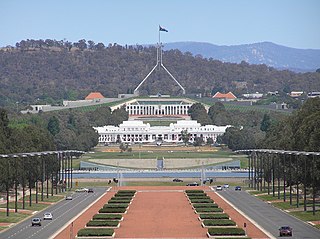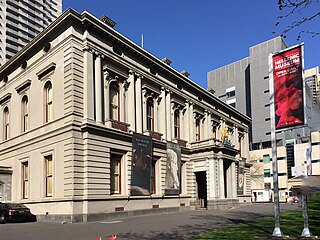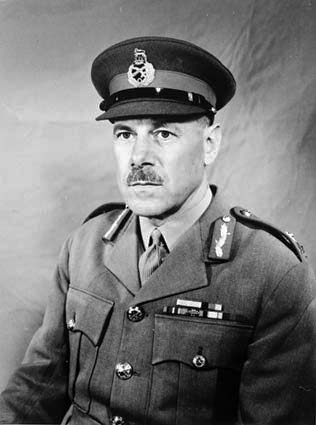
Canberra is the capital city of Australia. Founded following the federation of the colonies of Australia as the seat of government for the new nation, it is Australia's largest inland city and the eighth-largest Australian city overall. The city is located at the northern end of the Australian Capital Territory at the northern tip of the Australian Alps, the country's highest mountain range. As of June 2023, Canberra's estimated population was 466,566.

The Australian dollar is the official currency and legal tender of Australia, including all of its external territories, and three independent sovereign Pacific Island states: Kiribati, Nauru, and Tuvalu. As of 2022, it is the sixth most-traded currency in the foreign exchange market and also the seventh most-held reserve currency in global reserves.

John Smith Murdoch was a Scottish architect who practised in Australia from the 1880s until 1930. Employed by the newly formed Commonwealth Public Works Department in 1904, he rose to become chief architect, from 1919 to 1929, and was responsible for designing many government buildings, most notably the Provisional Parliament House in Canberra, the home of the Parliament of Australia from 1927 to 1988.

The Melbourne Mint, located on the corner of William and La Trobe Streets in Melbourne, Australia, was first established as a branch of the British Royal Mint, opening in 12 June 1872. The main building houses the administration offices, as well as the living quarters for the Deputy Master, his family and domestic servants in the right hand section. There is a pair of guard houses, one by each gate, and the assay and smelting works were in a range of buildings behind. It minted gold sovereigns from 1872 until 1931, and half-sovereigns (intermittently) from 1873 until 1915. In 1916 it commenced minting Commonwealth silver threepences, sixpences, shillings and florins. From 1923 it minted all pre-decimal denominations. It minted rarities such as the 1921/22 overdate threepence, 1923 half-penny and 1930 penny, as well as Australia's four commemorative florins in 1927 (Canberra), 1934/35, 1951 and 1954. It assisted the Royal Australian Mint in Canberra in producing one cent coins from 1966 to 1968 and two cent coins in 1966. From 1969 all coin production moved to the Royal Australian Mint in Canberra, and the building housing the coin minting equipment was demolished shortly afterwards. The remaining administrative building became the home of the Royal Historical Society of Victoria, as well as the civil marriage registry, with many weddings in the large ground floor room. Since 1998 it has been vested in a self funded-government body that manages a number of former government buildings, and it has hosted a range of tenants.
The Australian colonies and in the nineteenth century created offices involved in dealing with indigenous people in the jurisdictions.
David Gavin Dickson is an Australian freestyle swimmer who won three bronze medals in freestyle and medley relay events at the 1960 Summer Olympics and the 1964 Summer Olympics in Rome and Tokyo respectively.
Royal Melbourne Golf Club is a 36-hole golf club in Australia, located in Black Rock, Victoria, a suburb in southeastern Melbourne. Its West and East courses are respectively ranked number 1 and 6 in Australia. The West course is ranked in the top-five courses in the world. Founded 133 years ago in 1891, it is Australia's oldest extant and continually existing golf club. Unlike many metropolitan golf venues, The Royal Melbourne Golf Club has a capacity for 15,000 spectators.

The Australian Institute of Architects, officially the Royal Australian Institute of Architects, is Australia's professional body for architects. Its members use the post-nominals FRAIA (Fellow) and RAIA. The Institute supports 14,000 members across Australia, including 550 Australian members who are based in architectural roles across 40 countries outside Australia. SONA is the national student-membership body of the Australian Institute of Architects. EmAGN represents architectural professionals within 15 years of graduation, as part of the Australian Institute of Architects.

Royal tours of Australia by the British royal family have been taking place since 1867. Since then, there have been over fifty visits by a member of the Royal Family, though only six of those came before 1954. Elizabeth II is the only reigning monarch of Australia to have set foot on Australian soil; she first did so on 3 February 1954, when she was 27 years old. During her sixteen journeys, the Queen visited every Australian state and the two major territories.

The Embassy of Finland to the Commonwealth of Australia is Finland's diplomatic mission in Canberra, Australia. The mission is also accredited to New Zealand, Fiji, Papua New Guinea, Samoa, Tonga, Vanuatu and the Solomon Islands. As it is the only Finnish Embassy in the Southern Pacific region (Oceania), in practice the embassy also represents Finland in its relations with other Pacific island states in the region.
2CA is an Australian commercial radio station on the AM band serving Canberra. It is jointly owned by the Capital Radio Network and Grant Broadcasters. The station broadcasts on AM Stereo 1053 kHz and on DAB.

The shilling, informally called a "bob", was a type of silver coinage issued by the Commonwealth of Australia, that circulated prior to the decimalisation of Australian coinage. The Australian shilling was derived from the British pre-decimal sterling pound system and was first issued following the passing of the Australian Coinage Act 1909, which established Australia's first formal currency system. The shilling was issued as part of Australia's silver coinage, which included the two-shilling (florin), the sixpence and the threepence. The shilling was minted from 1910 until 1963. During this period there was one significant modification to the design of the Australian shilling, the change in its reverse design, which occurred in 1938 when the design was altered from the Australian coat of arms (1910–1936) to the visage of a Merino ram's head (1938–1963).

Foreign relations are present between Australia and Finland. Diplomatic relations were established on 31 May 1949. Australia is represented in Finland through its embassy in Stockholm, Sweden, and through an honorary consulate in Helsinki. Finland has had an embassy in Canberra since 1978, alongside honorary consulate generals in Melbourne and Perth, honorary consulates in Adelaide, Brisbane, Darwin, Hobart, and Sydney, and an honorary vice-consulate in Cairns.

Lieutenant General Sir Mervyn Francis Brogan, was a senior officer in the Australian Army who served as Chief of the General Staff from 1971 to 1973.
The Yarra Yarra Golf Club is a private golf club in Australia, located in Victoria at Bentleigh East, a suburb southeast of Melbourne. It is one of the eight Melbourne Sandbelt championship courses and is renowned for its par-3s.
"Peter Grimes" is a 1964 television play broadcast by the Australian Broadcasting Corporation. It was based on the opera by Benjamin Britten and directed by Christopher Muir.
Brigadier Eric Lacy Vowles, was an Australian soldier who served during the First World War and Second World War.

The Queen's Cup, formerly King's Cup, is a horse race run in different locations across Australia from 1927 in most years until the present day. It was originally held in each of the six states of Australia in rotation each year, but has not been held in strict rotation in recent decades. The length of the race is 2,400 m (1.5 mi), and since the 1990s it has been a Group 3 race. As of 2022, the most recent race was run in March 2022 at Rosehill Gardens Racecourse in Sydney.
















